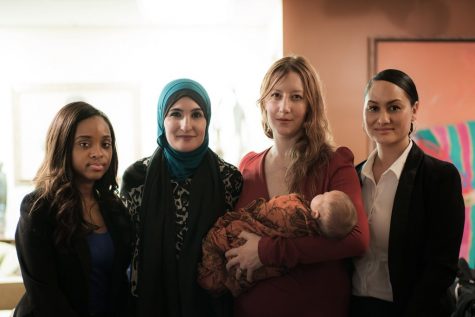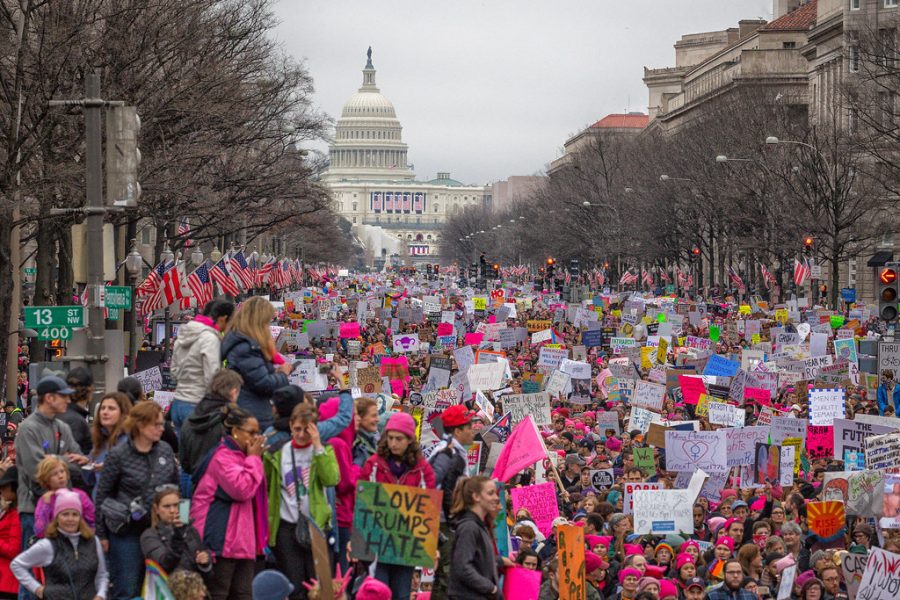The Complicated History of the Women’s March
By Mobilus In Mobili on Flickr
Thousands march in D.C. during the Women’s March in Washington.
January 29, 2019
You’ve probably heard of the Women’s March. It was started in lieu of Trump’s election as a way for women to show their unified support against him. Marches were held all over the country and millions of women attended. What you may not know is that the empowering event has since split in two. Due to disagreements about the purpose of the march, many cities held two different marches in January of 2019.
The Women’s March began when a woman from Hawaii, named Teresa Shook, created a Facebook event promoting a March in protest of Trump’s inauguration. The event was published just after he was elected and the march would take place the day after his inauguration in January of 2017.
Although there is now some confusion about the intent of the march, the official platform was released just a week before it took place. The platform addressed reproductive rights, immigration reform, healthcare reform, religious discrimination (primarily that against Muslim Americans), LGBTQ rights, gender and racial inequities (primarily those that favor men and Non-Hispanic whites, respectively), workers’ rights, and other issues.
The organizers also addressed environmental issues: “Every person . . . has the right to clean water, clean air, and access to and enjoyment of public lands . . . land and natural resources cannot be exploited for corporate gain.”
According to Time Out London, “build bridges, not walls” became a popular march slogan in direct opposition to one of Trump’s preeminent campaign promises.
Vanessa Wruble, a Brooklyn-based activist, was the first woman to organize the official March on Washington (the largest march, held in D.C.). To ensure that the march was led by women of different backgrounds, Wruble brought on Tamika D. Mallory, a gun control activist and black woman; Carmen Perez, a Latina criminal justice reform activist; and Linda Sarsour, former executive director of the Arab American Association of New York, to serve as National Co-Chairs alongside co-founder Bob Bland, an American fashion designer and activist.

From left, Tamika Mallory, Linda Sarsour, Bob Bland and Carmen Perez, four organizers of the Women’s March.
In an email to Tablet Magazine, Michael Skolnik, a high-profile activist, confirmed that he helped Wruble choose the new chairs. “I was contacted by Vanessa Wruble, who I have known for many years, asking for help with The Women’s March and specifically with including women of color in leadership,” he wrote. “I recommended that she speak with Tamika Mallory and Carmen Perez.”
Although the organizers gained a lot of traction for having led the march (the leaders would be named 2017 Women of the Year by Glamour Magazine and they were on Time Magazine’s list of the 100 Most Influential People), the March on Washington “had no real connection to the many marches that took place across the country and globally” said Wruble, in an interview with Tablet. “Local leaders, often first-time organizers, spearheaded marches in their own communities. Many used the branding we put out as open source and helped to make the marches look unified—which was certainly advantageous in creating the sense of a singular, massive movement—but they were the ones who did the real work.”
What started as a successful call-to-action soon went downhill. Despite the approximately four million women who marched all over the country (it was the largest single-day protest in U.S. History), the March on Washington had some conflicts bubbling up in its leadership. When Wruble told the group that her Jewish heritage inspired her to try to help repair the world, Tamika Mallory, and Carmen Perez, asserted that Jews needed to confront their own role in racism.
During the first meeting for what would become the Women’s March, Mallory and Perez allegedly claimed that Jewish people bore a particular collective responsibility as exploiters of blacks and even, according to a close second-hand source, claimed that some Jews were leaders of the American slave trade. These myths were first popularized by The Secret Relationship Between Blacks and Jews, a book by Louis Farrakhan’s Nation of Islam. It has been called “the bible of the new anti-Semitism,” by Henry Louis Gates Jr., an American literary critic. Mallory and Bland deny that the offenses took place, but, according to Tablet, “multiple sources with knowledge of what happened confirmed the story.” Mallory has called Farrakhan the “GOAT” (Greatest Of All Time) on social media.
At the end of January, according to multiple sources, there was an official debriefing in Mallory’s apartment. Evvie Harmon, who organized a Join the Impact protest in 2008 against the passing of the “California Marriage Protection Act”, was in attendance. She told Tablet recently that Mallory said that the problem was that there were five white women in the room and only three women of color and that she didn’t trust white women. Especially white women from the South. Mallory and Perez were berating Wruble about her being Jewish. They even claimed that Jews hold ‘all the wealth.’ Harmon was very used to hearing racist language used against blacks in rural South Carolina. But this time it was against Jews.
According to Tablet, Women’s March Inc. raised more than $3 million from CrowdRise and continue to make money through shirt sales and public interviews. Although the group recognized that other ‘sister’ marches made a huge impact on their success, they didn’t get any money. Refinery29 reported that when Women’s March Inc. filed a federal trademark registration for the March with the U.S. Patent and Trademark Office, 14 different organizations opposed it. “You do not trademark a movement,” Shook (the march’s Facebook founder) told Tablet. “The Women’s March should belong to all of us. The sister marches don’t get a dime.”

Vanessa Wruble, original organizer of the Women’s March, at her home.
Wruble was pushed out of the organization shortly after the first march. She stated that her Jewish identity played a role. She went on to help found an organization called March On in October 2017, which supports local women activists. In January of 2018, March On spearheaded many Women’s Marches around the country.
This year, there were two marches on January 19, 2019: one led by the Women’s March, promoted as being led by women of color, and another by a group affiliated with March On that stressed its denunciation of anti-Semitism.
The split in the Women’s March may be indicative of a larger schism in America’s Democratic Party. Questions have begun to emerge about the ideological values upon which the movement was built. When the March’s leaders first published their objectives, their platform read, “We must create a society in which women—in particular Black women, Native women, poor women, immigrant women, Muslim women, and queer and trans women—are free and able to care for and nurture their families, however they are formed, in safe and healthy environments free from structural impediments.” Observers questioned the absence of “Jewish” from the list and wondered if Jews—the vast majority of whom vote Democrat—would be welcomed in an evolving left.
AP Government Teacher Michael Brown said that rifts within political parties are common and that, in many cases, parties are not cohesive entities. “Largely they are an amalgamation of allied special interests,” Brown said. “And, at times, those interests work in concert and at other times there is discord.”
Brown mentioned that disagreements aren’t unique to today’s Democrats, either. “In the Republican party, there is a schism between the Traditional Conservative and the Trumpian Republican. There is a back and forth between social and economic conservatives,” Brown said.
White women have had lots of success, but what about the others? During suffrage movements just over a century ago, blacks were forced to march in the back of demonstrations or not march at all. For example, the National American Woman Suffrage Association prevented black women from attending their conventions. Black women had to march separately from whites in suffrage parades. They were often torn between focusing on black suffrage or women’s suffrage. Though they played large roles in getting the 15th and 19th amendments passed, much of their help was ignored.

New York City Women’s March, October 23 ,1915
Brown stated that political splinters have been around forever. “In the fifties there was a split between the northern Democrats who were more progressive and the Southern Democrats who opposed Civil Rights,” he said.
Since that time, we have made huge strides toward putting women in power. For the first time ever there are 100 women in the House of Representatives, but 80 percent of them are white. Pelosi was the first woman to become Speaker of the House. Madeleine Albright was the woman to become Speaker of the House. Hillary Clinton was the first woman to win a presidential nomination. Many white women are becoming CEOs. Women of color are not having nearly as much success. The Institute for Women’s Policy Research found that black women earn only 80 percent of what white women make. Will women begin to have different political interests?
Brown elaborated on the consequences of extreme interests infiltrating parties. “Schisms can have electoral consequences because either could party nominate someone who appeals to the base but isn’t marketable to the general public because they are a little too extreme,” said Brown. “Even if a moderate candidate was to win the nomination, how beholden will they be to the extremes of their party? What impact does that have on creating policy that people can get on board with?”




